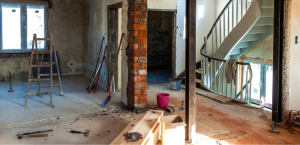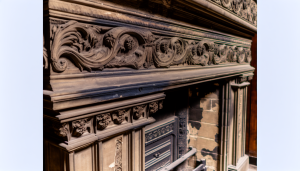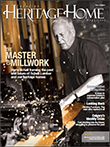This local landmark stands as a beautiful architectural gem, a reminder of our past, and as a testament to the adaptability of heritage structures.
By Adam Birrell
The Thornhill Village Library, located at 10 Colborne Street in historic Thornhill, Ontario, does not look like a library. If it weren’t for the small wooden sign at the front of the building, and the coming and going of faithful patrons, this 150-year-old building would camouflage perfectly with the heritage homes that line the street.
The building is home to one of the Markham Public Library’s six branches and houses some 30,000 books. Its comfortable armchairs and front parlour make it a popular destination for locals to meet, work and read.
Historical photos of local streets, buildings and people line the walls of the main entrance. Among these is a photograph of John Ramsden, the building’s first owner. Ramsden, a miller, had the home built in either 1845 or 1851, depending on which source you believe. He married Ellen Frizzell Lazier in 1847. When Ellen died in 1853 at the age of 39, she left the house to her infant son, John A. Ramsden, which is unusual for a number of reasons, none of which answers the question of why she didn’t leave it to her husband.
Some say Ellen Ramsden still watches over the building.
Staff began reporting strange sounds coming from the upstairs room soon after the library moved into the building. But the most notorious sighting took place in 1972 when a man spotted a woman sitting in a rocking chair in the back room. “John, John, John,” she muttered. When the man returned a few moments later with his wife the woman was gone.
While not everyone is convinced by the ghost stories, they’ve persisted enough to spur regular enquiries from patrons, young and old, thirsty for local supernatural tales.
***
The house was built in modest Classical Revival style with the front entrance at the centre of the street-facing gable end. The doorway, with its 18 pane transom, is framed by two smooth pilasters topped by a cornice. The two main floor windows, placed evenly on either side of the door, are the typical 12 over 12 panes, while the two smaller second storey windows in the gable reduce to six over six panes.
In keeping with the Classical Revival style, the slightly defined eaves in the gable return to create the illusion of a pediment. To the rear the house’s front section is a single-story tail wing.
The interior of the house appears to have been made up of three or four rooms on the main floor, with two bedrooms and a workroom on the second, accessed by an enclosed stairway. The front room is the parlour, which stretches the entire width of the house.
The original configuration of the house’s rear section is a matter of speculation. It is possible that the house had a small dining room here. Alternatively, if the tail wing was not built until slightly later this could have been the kitchen, possibly with a small main floor bedroom or “slip room.”
***
The Thornhill Public Library was relocated to this historic home in 1960. It was a prime example of adaptive re-use long before the term became fashionable. However, the library was not the first group to repurpose this home.
John Grice Jr., a merchant, and his family moved in sometime before 1891. The family operated their general store from the main floor of the house until 1902, after which they moved their business to a building directly to the west on Yonge Street.
The fact that this house would come to serve as a store even though it was a bit back from the main road is interesting. Like many one-and-a-half storey buildings of the era, it was built with the gable end facing the road. This made the building imposing and left a nice flat spot to for advertising.
A photograph taken in the 1920s shows a small extension on the east side of the original house. Part of the words “JOHN GRICE MERCHANT” were still clearly visible, painted on the vertical board siding over what appears to be a “boomtown” facade. Why this feature was retained after two subsequent occupants is anyone’s guess.
This photograph, along with another one taken during the 1920s, shows some of the changes different owners made to modernize the home. One such feature was the shed-roofed porch, with its turned posts and fretwork braces. The porch was likely an addition of the later part of Victorian era. The two over two sash windows, also visible, may have been altered around the same time to replace their 12 by 12 predecessors. The porch would have offered shade and comfort on hot summer days while the two over two pane windows would have been regarded as a more modern look, creating a less obstructed view to the outside.
Following the Grice family, John R. Campbell, a veterinarian, and his wife occupied the house sometime between 1902 and 1911. Between 1911 and 1931, Murdoch McDonald and his children Norm, Bill, Christina and Mary lived there, operating a livery stable from the barns behind the house. During the 1930s Mr. and Mrs. Jim Tutt lived there with their seven children, followed by Bill and Mae Francis from about 1940 to 1948.
The last family to occupy the house, from 1948 to 1959, was Frank Tucker, his wife and their six children.
In 1959, the Thornhill Public Library was actively searching for a permanent home. Since its establishment in 1897 as an association library, and public library in 1952, the library has relocated numerous times — three times in the 1950s alone.
With the financial assistance of the Thornhill Lions Club, the Library Board was able to purchase 10 Colborne Street for $16,000 ($118,000 in today’s dollars).
The original house served the library until 1972 when a lack of funds and space threatened to shut it down. Public opposition forced the reversal of the decision to close the library. The same year, they added two portables to the rear of the building to increase the collection space.
By the mid-1970s, the operation of the library program, with its high traffic and weighty books, had taken its toll on the building’s structure and it was agreed that something had to be done to ensure its future.
The library turned maintenance of the house over to the Town of Markham in 1977 in exchange for the costs of renovation and restoration. Architect, B. Napier Simpson Jr., one of the fathers of the modern heritage movement whose office happened to be next door to the library, was hired to draw up plans for the restoration and structural reinforcement.
The structural work involved the construction of a new foundation with full basement, the stabilization of the main and second storey floors with reinforcement beams, the removal of the dilapidated garage (to be replaced by a new kitchen and washroom addition), and a new entrance vestibule on the building’s west side.
***
By 1991, the desire for more space, wheelchair accessibility, and the disposal of the two temporary portables, which had become home to a variety of wildlife, led to the plans for a new permanent addition.
Following the demolition of the portables, which fell far too easily for anyone’s comfort, construction began on an addition that would suit the architectural style of the historic home and meet the needs of its diverse patrons.
Today, this historic landmark, now over 150 years old, continues to serve the Thornhill Village Library — not in spite of its age, but in some ways because of it. Library visitors are able to experience a great deal beyond the services the library has to offer. It even has a ghost.







